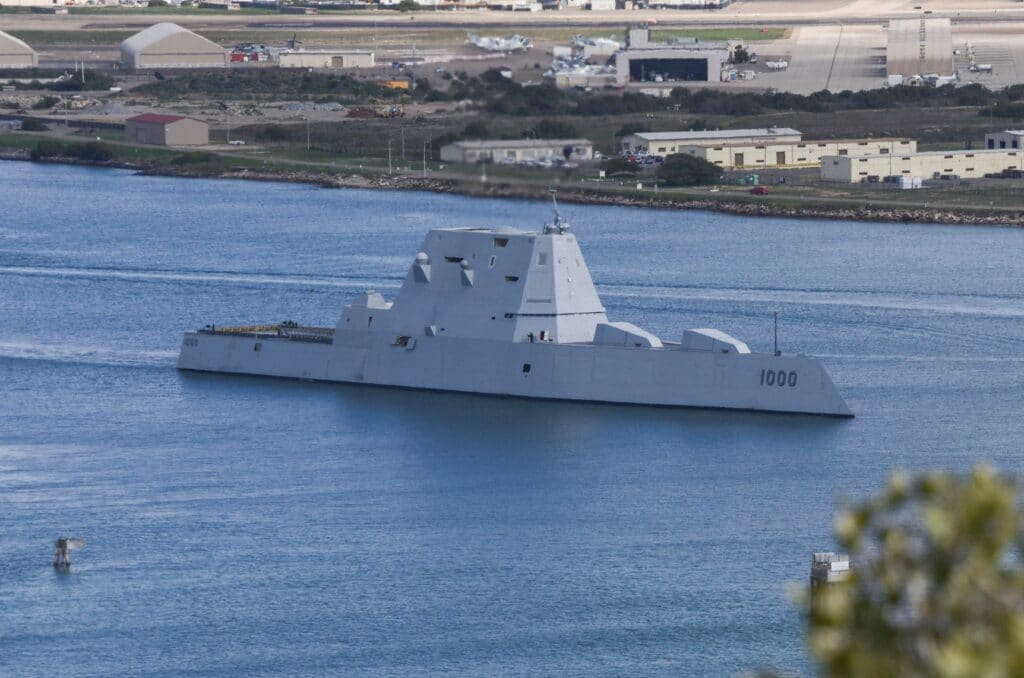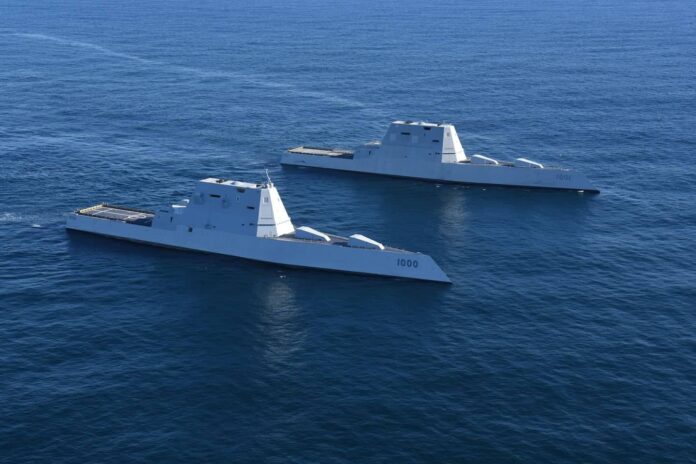According to the latest budget documents, the US Navy plans to outfit Zumwalt-class destroyers on each three with 12 hypersonic missiles. The Department of the Navy incorporated in its fiscal year 2022 budget proposal a request for funding to put the Conventional Prompt Strike (CPS) Weapon onto all three Zumwalt-class destroyers. So, what are the reasons behind this change?
Background of the Project
The DDG-1000 program was initiated in the early 1990s. DDG-1000s are multi-mission destroyers with an originally intended emphasis on naval surface fire support (NSFS) for friendly forces operating ashore. DDG-1000s were initially intended to replace, in a technologically more modern form, the large-calibre naval gunfire capability that the Navy lost when it retired its Iowa-class battleships in the early 1990s. It will improve the Navy’s general capabilities for operating in defended coastal waters and introduce several new technologies available for use on future Navy ships. The DDG-1000 design incorporates an integrated electric-drive propulsion system and automation technologies enabling its reduced- reduced-size crews of 175 sailors (147 to operate the ship, plus a 28-person aviation detachment), compared to roughly 300 on the Navy’s Aegis destroyers and cruisers, to reduce its operating and support (O&S) costs.

With an estimated total load displacement of 15,656 tons, the DDG-1000 design is substantially more significant than the Navy’s Aegis cruisers and destroyers, which have displacements of up to about 9,700 tons, and are more critical than any Navy destroyer or cruiser since the nuclear-powered cruiser Long Beach (GCN-9), which was procured in 1957.
The first two DDG-1000s were procured in the Fiscal Year 2007 (Y2007) and split-funded (i.e., funded with two-year incremental funding) in FY2007-FY2008; the Navy’s FY2021 budget submission estimates their combined procurement cost at $9,450.8 million. The third DDG-1000 was procured in FY2009 and split-funded in FY2009-FY2010; the Navy’s FY2021 budget submission estimates its procurement cost at $3,855.1 million.
The first DDG-1000 was commissioned into service on September 7, 2016. Its delivery date was revised multiple times. In the Navy’s FY2021 budget submission, the ship’s delivery date was changed to March 2020. The ship’s actual delivery date reportedly was April 2020. This created an unusual situation in which a ship was commissioned into service more than three years before its delivery date. The delivery dates for the second and third ships have also been revised multiple times. In the Navy’s FY2022 budget submission, the delivery dates for the two boats were changed to March 2022 and April 2024, respectively.
New Technologies The DDG-1000 incorporates a significant number of new technologies, including a wave-piercing, tumblehome hull design for reduced detectability, a superstructure on the first two ships, but not the third that is made partly of large sections of composite (i.e., fiberglass-like) materials rather than steel or aluminium, an integrated electric-drive propulsion system, a total ship computing system for moving information about the ship, automation technologies enabling its reduced-sized crew, a dual-band radar (that was later changed to a single-band radar), a new kind of vertical launch system (VLS) for storing and firing missiles. Two copies of a new 155mm gun called the Advanced Gun System (AGS).
The U.S. Navy plans no further procurement of DDG-1000s and LRLAP
As noted earlier, in FY2007-FY2009, when the Navy was not procuring DDG51s, the Navy instead procured three Zumwalt (DDG-1000) class destroyers. The Navy plans no further procurement of DDG-1000s.
DDG-1000s are multi-mission destroyers with an originally intended emphasis on naval surface fire support (NSFS) and operations in littoral (i.e., near-shore) waters. NSFS is the use of naval guns to provide fire support for friendly forces operating ashore. Consistent with that mission orientation, the ship was designed with two new design 155mm guns called Advanced Gun Systems (AGS’s).

The AGS’s were to fire a new 155mm, gun-launched, rocket-assisted guided projectile called the Long-Range Land-Attack Projectile (LRLAP). When the Zumwalt class was cut from a planned 30 ships to only three, the economics of scale for producing the AGS’s unique ammunition became skewed, and the cost-per-round skyrocketed to nearly the same as a Tomahawk cruise missile, which has a larger warhead and a range of almost 1,000 miles.
In November 2016, however, it was reported that the Navy had decided to stop procuring LRLAP projectiles because the projected unit cost of each projectile had risen to at least $800,000. Since the guns cannot fire any of the other precision artillery shells already in production, the guns had become dead weight. Given the extraordinary cost, the Navy decided to cancel any additional ammunition bought for the AGS five years ago.
The Navy plans no further procurement of DDG-1000s and LRLAP
As noted earlier, in FY2007-FY2009, when the Navy was not procuring DDG51s, the Navy instead procured three Zumwalt (DDG-1000) class destroyers. The Navy plans no further procurement of DDG-1000s.
DDG-1000s are multi-mission destroyers with an originally intended emphasis on naval surface fire support (NSFS) and operations in littoral (i.e., near-shore) waters. NSFS is the use of naval guns to provide fire support for friendly forces operating ashore. Consistent with that mission orientation, the ship was designed with two new design 155mm guns called Advanced Gun Systems (AGS’s).
The AGS’s were to fire a new 155mm, gun-launched, rocket-assisted guided projectile called the Long-Range Land-Attack Projectile (LRLAP). When the Zumwalt class was cut from a planned 30 ships to only three, the economics of scale for producing the AGS’s unique ammunition became skewed, and the cost-per-round skyrocketed to nearly the same as a Tomahawk cruise missile, which has a larger warhead and a range of almost 1,000 miles.

In November 2016, however, it was reported that the Navy had decided to stop procuring LRLAP projectiles because the projected unit cost of each projectile had risen to at least $800,000. Since the guns cannot fire any of the other precision artillery shells already in production, the guns had become dead weight. Given the extraordinary cost, the Navy decided to cancel any additional ammunition bought for the AGS five years ago.
The new mission of DDG-1000 with Navy’s recent hypersonic Conventional Prompt Strike (CPS) missile
In December 2017, due to shifts in the international security environment and resulting changes in Navy mission needs, the mission orientation of the DDG-1000s will be shifted from an emphasis on NSFS to a focus on surface strike, meaning the use of missiles to attack surface ships and perhaps also land targets.
In April and May 2021, it was reported that the Navy plans to remove the AGSs on the three ships and replace them with vertical launch tubes for the 12 Navy’s new hypersonic Conventional Prompt Strike (CPS) missile, as a “compelling strike platform,” according to the Navy’s fiscal year 2022 budget request with a goal of fielding CPSs on a DDG-1000 class ship by 2025.
To put hypersonic weapons on the Zumwalt class, huge new launch tubes need to be installed. The Zumwalt’s two Advanced Gun System mounts, located on the ship’s forward section, will be removed to fit new launchers. An “Advanced Payload Module” will be installed in their place that will carry and launch up to 12 CPS weapons.

The Navy is set to debut its first at-sea hypersonic missiles aboard one of the service’s three Zumwalt-class destroyers in four years. Rather than have the Navy’s first weapons capable of travelling Mach 5 of faster fire from guided-missile submarines “by 2025,” as previously planned, the Zumwalts would be the first platform to field CPS weapons.
Conclusion
Replacing the Zumwalts’ unusable guns with hypersonic weapons will give the ships a strategic-level capability without sacrificing any of its existing 80 vertical launchers, which are still needed for air defence and anti-ship missiles. The hypersonic weapon modification “provides a flexible, surface combatant launched long-range strike capability through the ships’ remaining service life. When combined with the low observable characteristics of the Zumwalt platform, the funds provide a compelling strike capability from a platform designed to complicate an adversaries’ targeting problem.
As a result, we can say that the changes made are compatible with the fundamental principle expressed in the concept of distributed lethality.
Check out Naval Library App to find out the specifications of Zumwalt-class destroyer.





